In the business development (BD) lifecycle, there are many roles or labor categories that support a win in a competitive procurement. They include business developers, capture managers, proposal managers, solution architects, program managers, subject matter experts, pricing experts, technical writers, graphic artists, and others. Plus, with the emergence of generative AI in different types of BD lifecycle software platforms, a relatively new role has emerged out of necessity: prompt engineering.
From my 25-plus years providing professional services in the government contracting market space, spanning client delivery to managing programs to capturing new opportunities, it has become apparent to me that all of these roles are essential to helping win a competitive procurement. However, they are increasingly insufficient.
In fact, there is a gap in the market space when it comes to the necessary upfront thinking needed to win a competitive procurement, particularly one that is high- value, mission-critical, complex, and solution-based.
The key to winning a competitive procurement is being able to answer the most important question, “Why your company?” To do this, you must persuade the customer that your company can provide the most value. This means benefit realization (preferably quantified) and risk mitigation.
There are no shortcuts to being able to answer this question. It takes both time and effort from the many aforementioned roles essential to winning a competitive procurement.
Do not think for a minute that the use of generative AI is a shortcut. It is not. Yes, it may provide productivity gains, but more output does not necessarily translate to outcomes (i.e., competitive wins). Experienced practitioners in the government contracting market space know that this point is true.
What is the foundation, then, for winning a competitive procurement? The answer is dialogue between two or more people. With it, individuals bring information from many and diverse sources to the discussion, such as from:
- Meeting with the customer
- Industry Days
- Discussions with potential competitors or teaming partners
- Freedom of Information Act requests
- 3rd-party business intelligence vendors
- Organic information from within the company’s customer relationship management system
- Independent research from the Government Accountability Office
- Information retrieved from the company’s own knowledge repository
- Implicit customer, company, or competitor knowledge in company employee heads
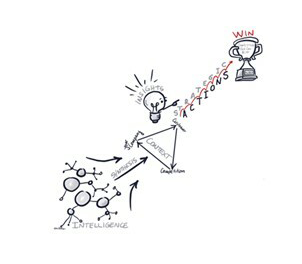 For the interaction to be effective, it should be structured around a sound collaborative analytical activity to get the best context of the company, customer, and competition to make the right decisions to move the company along to a more improved position to enable a competitive win.
For the interaction to be effective, it should be structured around a sound collaborative analytical activity to get the best context of the company, customer, and competition to make the right decisions to move the company along to a more improved position to enable a competitive win.
This might include dialogue-based collaborative analytical activities such as an Issue and Key Factor Analysis, a Competitive Assessment, a Discriminator Qualification, a Gap Analysis, and a Win Strategy Formulation.
The Problem
Many contributors to winning a competitive procurement (e.g., business developers, capture managers, proposal managers, solution architects) lack the knowledge, skills, and ability to effectively facilitate the necessary dialogue-based collaborative analytical activities needed to win a competitive procurement.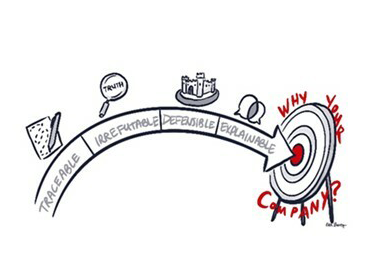
A key value of a facilitator is their independence. A good facilitator will not become part of the groupthink, which often occurs with competitive pursuit teams. Instead, they will challenge members of the group to provide traceable, irrefutable, defensible, and explainable rationale behind their thinking and statements.
This mitigates the kind of thinking shown below that fails to answer, “Why your company?” and contributes to a competitive loss:
- “The customer loves us.”
- “We’re the only ones who can do that.”
- “Company XYZ won’t be selected.”
- “This past performance will work because we used it before.”
- “Let’s reuse the same approach that we used on our last bid.”
In addition, the hybrid/remote work environment resulting from the COVID-19 pandemic appears here to stay. It makes the dialogue-based, collaborative analytical activity that is necessary to win a competitive procurement all the more challenging, despite the availability of modern video-conferencing technology. This is because there is no substitute for in-person collaborative face-to-face interaction.
This is further compounded by the increased need for workforce mentoring of less experienced personnel due to the increasing post-pandemic retirements of more experienced BD lifecycle professionals.
Each of these challenges makes it more difficult to win a competitive procurement. A capable Solution Facilitator leading the necessary dialogue-based collaborative analytical activities needed to win a competitive procurement and mentoring as necessary in the new hybrid/remote work environment will more likely contribute towards success (i.e., competitive win).
Why Is This New Role Needed?
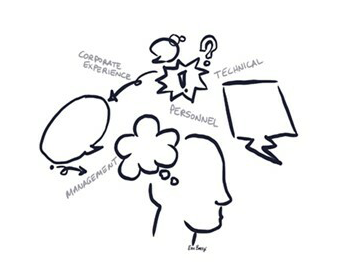 Winning competitive procurements is a “thinking person’s business.” This thinking takes a lot of time. Very few business developers, capture managers, solution architects, and proposal managers have enough time as it is to focus on facilitating the collaboration and necessary upfront thinking needed to win a competitive procurement during the Opportunity Assessment and Capture Phases of the BD lifecycle.
Winning competitive procurements is a “thinking person’s business.” This thinking takes a lot of time. Very few business developers, capture managers, solution architects, and proposal managers have enough time as it is to focus on facilitating the collaboration and necessary upfront thinking needed to win a competitive procurement during the Opportunity Assessment and Capture Phases of the BD lifecycle.
What Would the New Role Do?
The Solution Facilitator would help develop the “blueprint to win” by acting as an independent party facilitating dialogue-based collaborative analytical activities (e.g., Discriminator Qualification, Past Performance Analysis).
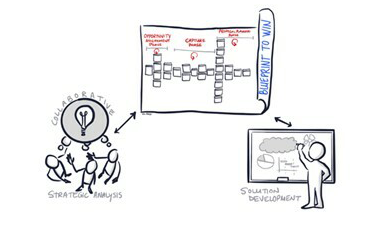 They would ensure that participating competitive pursuit team members do not make unsubstantiated claims, and are not too influenced by their own experiences, biases, or prejudices. They would ask clarifying and qualifying questions as part of performing root cause analysis to get to the most accurate rationale in points made. They would look for deeper information when someone stated something like “XYZ is a customer benefit,” by asking questions such as:
They would ensure that participating competitive pursuit team members do not make unsubstantiated claims, and are not too influenced by their own experiences, biases, or prejudices. They would ask clarifying and qualifying questions as part of performing root cause analysis to get to the most accurate rationale in points made. They would look for deeper information when someone stated something like “XYZ is a customer benefit,” by asking questions such as:
- “Can the benefit be quantified?”
- “To whom in the customer organization is it a benefit and why?”
- “Is the benefit supported by past performance and evidence of prior customer satisfaction?”
Plus, with the increasing use of GenAI in support of competitive procurements, they would enable authentic intelligence about the customer, company, and competitive to be captured.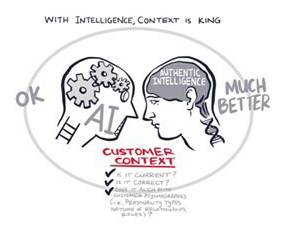
This helps and overcome the common limitation of generative AI use in competitive procurements: a lack of context (i.e., What’s the prompt based on? How do you know “the goodness” of the result?). This is because the source of truth is captured, challenged, and validated at its source of origin (i.e., the collaborative dialogue occurring via the Solution Facilitator along with other members of the pursuit team).
Why Can’t Existing Members of a Competitive Pursuit Team Do This Role?
This role needs to be an independent third-party, free from the biases that existing members of a competitive pursuit team typically bring. They need to be able to challenge beliefs and assumptions about the company, customer, and competition.
The role needs to enable deriving evidence-based thinking and facts from other members of the competitive pursuit team (e.g., business developer, capture manager, solution architect) so that unsubstantiated claims do not take on a life of their own. For example, “We have the most experienced team.” Where is the quantitative evidence? What quantifiable customer benefit realization and/or risk mitigation has the team provided before on programs of similar size, scope, and complexity?
More than anything, this role needs to look at key members of the competitive pursuit team as their company-internal customers (e.g., solution architect, proposal manager), ensuring they receive the necessary information for them to perform their roles successfully. For example, they would ensure that the solution architect has the strategies needed to factor into the development of their solution the highlighting of company strengths, the minimizing of its weaknesses, the neutralizing of competitor strengths, and the exploiting of their weaknesses.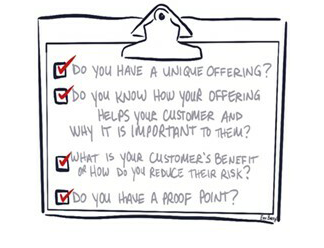
They would ensure that company discriminators are truly qualified and proven, going beyond just saying, “We’re unique”. As another example, for the proposal manager, they would ensure that an inventory of validated scorable strengths exists in advance of any proposal writing to be allocated against the requirements and evaluation factors.
Who Is Best to Deliver This New Role?
The Solution Facilitator is a consultative role. This means that the ideal individual for this role would possess the following attributes:
• High Ethical Standards • Adaptability • Judgment
• Communication • Advisory skills • Systems thinking
• Problem solving • Attention to detail • Strategic thinking
• Analytical skills • Relationship building • Trust building
• Confidence • Creativity • Continuous learning
• Drive • Flexibility • Listening
• Curiosity • Professionalism • Technical knowledge
• Interpersonal skills • Client Delivery Experience
When and Where Could the New Role Be Involved?
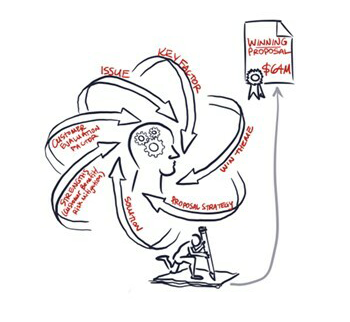 The Solution Facilitator could be involved throughout the BD lifecycle. They might facilitate an analysis with the business developer to help decide whether or not a particular opportunity merits being proposed to be entered into the company pipeline of opportunities.
The Solution Facilitator could be involved throughout the BD lifecycle. They might facilitate an analysis with the business developer to help decide whether or not a particular opportunity merits being proposed to be entered into the company pipeline of opportunities.
They might facilitate different types of Competitive Assessment activities such as Strength, Weakness, Opportunity, Threat (SWOT) Analysis; Bidder Comparisons; Porter Five Forces Analysis; or a Black Hat Review. They might work with the proposal manager to adjudicate the many proposal strategy inputs resulting from certain analyses (e.g., SWOT Analysis) to determine how and where to address them in the proposal response.
How Will Companies Pay for This New Role?
The short answer is that the companies most committed to winning will pay for this new role.
It’s just like when a company builds a software application. If, in an attempt to “reduce costs”, the necessary system’s analysis activities are not properly performed upfront (e.g., requirements, particularly security; cost-benefit; testability),the cost of rectifying improperly conducted activities later in the development lifecycle becomes much greater, particularly if it involves business or mission failure.
This is analogous to the BD lifecycle for competitive procurements. If the necessary early analyses needed to occur during the Opportunity Assessment and Capture Phases of the BD lifecycle do not occur, then it is likely it will cost even more to attempt to address them during the pre-proposal planning and proposal development phases of the BD lifecycle. Plus, an even greater cost is the opportunity cost of a competitive loss.
The Benefits of the Solution Facilitator Role
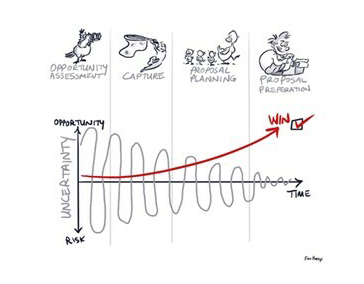 The benefits of adding the Solution Facilitator role to competitive pursuit teams are many. Let’s call out two in particular.
The benefits of adding the Solution Facilitator role to competitive pursuit teams are many. Let’s call out two in particular.
First, the facilitation of dialogue-based, structured collaborative analytical activities allows for the best context of the company, customer, and competition to be captured. Again, think of authentic intelligence. More importantly, it reduces uncertainty, and the sooner the better. The benefits of adding the Solution Facilitator role in turn contribute to the likelihood of making the right decisions throughout the BD lifecycle to move the company along to a more improved position to enable a competitive win. 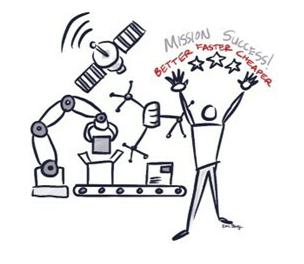
Second, and most important, it increases the likelihood of successfully executing awarded competitive procurements in a manner that exceeds customer cost, schedule, and performance thresholds.
Peter Lierni (CAP.APMP & CP.APMP) is founder of Solutioneering and originator of the Solution Engineering Framework™, which is a simple, yet powerful, deliberate, collaborative, engineering-based approach to designing winning proposal solutions. The Solution Engineering Framework is also automated as a software called “SET™”. Contact him at plierni@solutioneering.company to learn more.



Join the Conversation